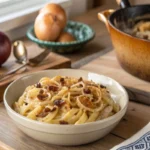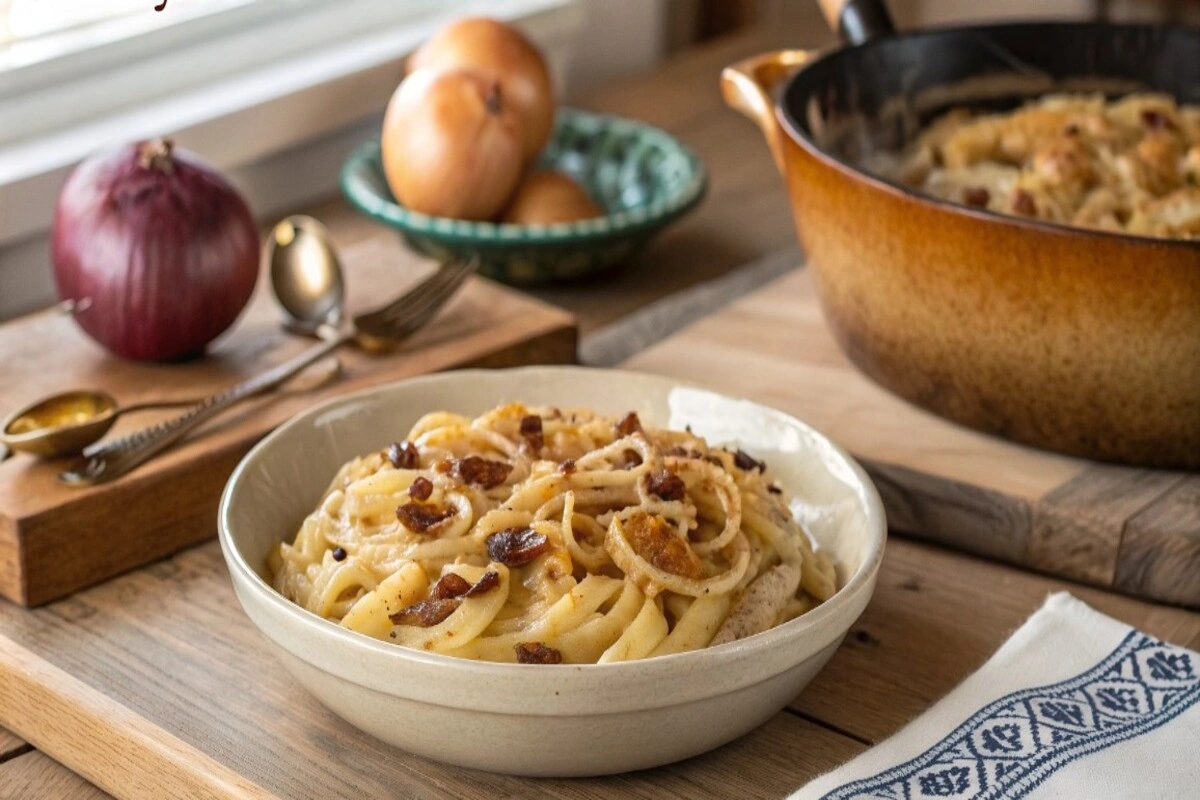A cozy dish blending sweet caramelized onions, creamy cheese, and rich broth. Learn how to create french onion pasta at home with ease and flavor.
What Is French Onion Pasta?
French onion pasta is a savory dish inspired by the well-loved French onion soup. Basically, it takes that distinctive caramelized onion flavor and merges it with tender noodles, creamy cheese, and rich broth. Indeed, it evokes the same comforting warmth and deep, sweet onion aroma. Moreover, it brings a gourmet flair right to your kitchen. Undoubtedly, this meal captures the essence of the classic soup but transforms it into a hearty, substantial pasta dish.
However, it is not just about onions. Conversely, the best french onion pasta strikes a perfect balance. Accordingly, the onions cook until sweet and jammy. Another key step involves adding a savory broth and a melting cheese that brings creaminess. Eventually, the pasta absorbs all these flavors, resulting in a satisfying forkful every time. Thus, it appeals to both soup lovers and pasta enthusiasts.
Basically, this recipe feels luxurious yet remains accessible. Furthermore, you can serve it as a main dish or present it as part of a holiday feast. Comparatively, it can impress guests or comfort you on a quiet evening. Altogether, french onion pasta exemplifies that blending flavors from familiar classics can yield exciting new meals.
The Story Behind French Onion Pasta
While no ancient text defines the exact origin of french onion pasta, it likely emerged as a creative twist on French onion soup. Eventually, as fusion cuisine gained traction, people started incorporating soup flavors into various dishes. Particularly, the sweet-savory onions and nutty cheese present in the soup lent themselves well to pasta. Consequently, chefs and home cooks experimented until they perfected a comforting bowl that honors the original but stands on its own merit.
Initially, it might have seemed like a novelty. However, the concept endures because the flavor combination is timeless. Indeed, the caramelized onions provide a sweet base. Meanwhile, cheese and broth add richness and complexity. Comparatively, adding pasta increases heartiness and makes it a more filling main course. Basically, this culinary marriage reflects how food traditions evolve while respecting classic tastes.
The Appeal of French Onion Pasta in Home Cooking
Undoubtedly, this dish resonates with home cooks looking for something comforting. Consequently, it requires simple techniques: caramelizing onions, simmering broth, and mixing in cheese. Despite its gourmet aura, anyone with patience can achieve excellent results. Therefore, it becomes an attainable meal that feels elegant without demanding advanced skills.
Moreover, french onion pasta supports endless customization. Accordingly, you can select your favorite pasta shape or choose a preferred cheese. Eventually, you might add herbs, spices, or even a protein. Basically, it adapts to your pantry and personal taste. Hence, it encourages experimentation and personal flair.
Because onions are inexpensive and widely available, this dish remains budget-friendly. Meanwhile, the result tastes like something ordered at a fine restaurant. Comparatively, it proves that you can create gourmet flavors in your own kitchen. Indeed, french onion pasta embodies the idea that a few humble ingredients, treated with care, become extraordinary.
Key Ingredients for French Onion Pasta
Main Components
- Onions: The star of this dish. Caramelized onions offer sweetness and depth.
- Cheese: Usually Gruyère or Swiss, but you can opt for another mild, nutty cheese.
- Broth: A rich, savory broth is vital. Beef or vegetable broth both work.
- Pasta: Choose a shape that holds sauce well, like fettuccine or rigatoni.
Supporting Flavors
- Butter and Oil: They help caramelize onions evenly without burning.
- Herbs (like thyme): Add subtle earthiness.
- Garlic: Enhances savory depth.
- White Wine (optional): Deglazes the pan and lifts complex flavors.
Step-by-Step Instructions for French Onion Pasta
Below is a detailed recipe to achieve authentic french onion pasta. Basically, follow these steps for a comforting meal.
Ingredients (Serves 4):
- 2 tablespoons unsalted butter
- 1 tablespoon olive oil
- 3 large yellow onions, thinly sliced
- 1 teaspoon granulated sugar (optional, to aid caramelization)
- 2 cloves garlic, minced
- ½ cup dry white wine (optional, can substitute with more broth)
- 2 cups beef or vegetable broth
- 1 teaspoon dried thyme (or 1 tablespoon fresh thyme leaves)
- 8 ounces (about 225 g) short pasta (e.g., penne, fusilli, or rigatoni)
- ½ cup grated Gruyère cheese (or Swiss cheese)
- Salt and freshly ground black pepper, to taste
Instructions:
- Caramelize the Onions:
- In a large, deep skillet or pot, melt the butter and olive oil over medium heat.
- Add the sliced onions and sprinkle with sugar (if using) to help with caramelization.
- Cook, stirring occasionally, for about 20–25 minutes or until the onions are a deep golden brown. Adjust the heat if the onions begin to brown too quickly.
- Add Garlic and Wine:
- Stir in the minced garlic and cook for 1 minute, making sure it doesn’t burn.
- Pour in the white wine (if using) to deglaze the pan, scraping up any browned bits from the bottom of the pan. Simmer for about 2–3 minutes, allowing the alcohol to evaporate.
- Simmer the Sauce:
- Add the beef or vegetable broth and the dried thyme. Season with salt and pepper.
- Lower the heat and let the mixture simmer gently for about 5–7 minutes to develop flavor.
- Cook the Pasta:
- Meanwhile, cook the pasta in a separate pot of salted boiling water according to package instructions until al dente.
- Drain the pasta, reserving about ½ cup of the pasta cooking water.
- Combine Pasta and Sauce:
- Add the cooked pasta to the skillet with the caramelized onion sauce.
- Stir well to coat the pasta evenly. If the sauce looks too thick, add a splash of the reserved pasta water.
- Add Cheese and Serve:
- Sprinkle in the grated Gruyère cheese and stir until it melts and coats the pasta.
- Taste and adjust seasoning with more salt, pepper, or thyme if desired.
- Serve hot, garnished with additional thyme or cheese if you like.
Tips and Tricks for Perfect French Onion Pasta
- Patience with Onions: Caramelization takes time. Conversely, rushing leads to bitter onions. Thus, go low and slow.
- Season in Layers: Add small amounts of salt at different stages. Consequently, the final flavor becomes balanced.
- Cheese Quality Matters: Undoubtedly, better cheese elevates the dish.
- Adjust Consistency: Use pasta water to achieve the desired creaminess.
- Experiment with Herbs: Try rosemary or sage for unique variations.
Common Mistakes and How to Avoid Them
- Overcooking Onions: Burnt onions ruin the sweetness. Adjust heat if onions brown too fast.
- Choosing the Wrong Broth: A weak broth results in bland flavor. Pick a rich, low-sodium option.
- Overloading with Cheese: Too much cheese can overwhelm. Add cheese gradually.
- Skipping the Deglaze Step: Deglazing adds complexity. Do not skip it.
Variations of French Onion Pasta
- Vegetarian: Use vegetable broth and skip cheese or try a plant-based alternative.
- Protein Additions: Add shredded chicken or sautéed mushrooms for a heartier meal.
- Wine-Free: Replace white wine with extra broth if you prefer.
- Different Pasta Shapes: Experiment with penne, shells, or even whole-grain pasta.
Serving and Pairing Ideas
French onion pasta stands on its own as a comforting main dish. However, consider complementing it with a crisp green salad. Meanwhile, crusty bread helps soak up every drop of sauce. Likewise, roasted vegetables add color and nutrients. Furthermore, if you crave variety, serve it with light snacks like chicken minis or pair it with a grilled cheese burrito for a fun fusion twist.
For dessert, try something sweet and flaky. Afterward, treat yourself to a dessert like pastelitos or a bright, fruity finale like a peach crumble recipe. Another approach could be enjoying fresh fruit on the side. Altogether, these simple additions create a balanced meal.
Nutritional Information
While french onion pasta offers comfort, it also provides certain nutrients. Its onions contribute vitamins and fiber. Meanwhile, cheese adds protein and calcium. However, it can be rich, so enjoy moderate portions and consider using lower-fat cheese or whole-grain pasta for a healthier twist.
Nutritional Content (per 100g)
| Nutrient | Amount (per 100g) |
|---|---|
| Calories | 210 kcal |
| Protein | 7 g |
| Carbohydrates | 23 g |
| Fat | 9 g |
| Fiber | 2 g |
| Sodium | 180 mg |
Storing and Reheating Tips
Leftover french onion pasta can be stored in an airtight container. Keep it in the refrigerator for up to three days. When reheating, add a splash of broth or water. Consequently, this prevents it from drying out. Heat gently over low heat. Moreover, taste and adjust seasonings as flavors may mellow in the fridge.
Enhancing the Flavor Further
Consider topping your pasta with toasted breadcrumbs for crunch. Moreover, a drizzle of olive oil adds gloss. Another idea involves scattering fresh thyme or chopped parsley right before serving. Additionally, a spoonful of sour cream can provide tangy contrast. Basically, be creative and find what flavors you enjoy most.
Exploring the Culinary Roots
French onion pasta borrows from centuries-old French culinary traditions. Indeed, French onion soup traces back to simple peasant dishes. Over time, it gained fame for its comforting warmth. Accordingly, this pasta adaptation pays tribute to that history. Undoubtedly, it shows how beloved flavors can inspire new creations.
Frequently Asked Questions (FAQs)
What type of cheese works best in french onion pasta?
Gruyère is the classic choice. However, Swiss, fontina, or mild provolone also work well.
Can I use vegetable broth instead of beef broth?
Indeed, vegetable broth provides a lighter flavor, making it a good vegetarian alternative.
How do I ensure the onions caramelize properly?
Cook them slowly over low heat. Stir often. If they stick, add a bit of water. Patience ensures sweetness.
What if I do not have white wine?
Simply use more broth. You still get a savory flavor, though wine adds extra complexity.
Can I reheat leftover french onion pasta?
A: Yes, add a splash of broth while reheating over low heat. This approach helps maintain creaminess and flavor.
Is there a healthier version?
Use whole-grain pasta and less cheese. Additionally, opt for a low-sodium broth. You can easily adjust ingredients for a lighter dish.
Does french onion pasta taste like French onion soup?
Comparatively, it shares a similar caramelized onion profile and cheesy goodness. However, the pasta adds heartiness and texture, making it unique.
Conclusion: Savoring the Delight of French Onion Pasta
In the end, french onion pasta offers more than just a meal. Consequently, it brings together the caramelized sweetness of onions, the richness of cheese, and the warmth of broth. Furthermore, it transforms familiar flavors into a comforting dish that feels both nostalgic and new. Indeed, this dish proves that a few humble ingredients, treated with patience and care, yield exquisite results. Finally, try french onion pasta for yourself. Unquestionably, it will become a cherished favorite in your recipe repertoire.
Print
Savory French Onion Pasta: A Comforting Classic
- Total Time: 40 minutes
- Yield: 4 servings 1x
Description
This French Onion Pasta marries the comforting flavors of classic French onion soup with a hearty pasta dish. Caramelized onions lend a sweet, savory depth, while beef or vegetable broth and a splash of wine create a rich, silky sauce. Finished with melted Gruyère cheese, this pasta is truly indulgent—perfect for cozy dinners and impressive enough for guests!
Ingredients
- 2 tablespoons unsalted butter
- 1 tablespoon olive oil
- 3 large yellow onions, thinly sliced
- 1 teaspoon granulated sugar (optional, to aid caramelization)
- 2 cloves garlic, minced
- ½ cup dry white wine (optional, can substitute with more broth)
- 2 cups beef or vegetable broth
- 1 teaspoon dried thyme (or 1 tablespoon fresh thyme leaves)
- 8 ounces (about 225 g) short pasta (e.g., penne, fusilli, or rigatoni)
- ½ cup grated Gruyère cheese (or Swiss cheese)
- Salt and freshly ground black pepper, to taste
Instructions
Caramelize the Onions:
- In a large, deep skillet or pot, melt the butter and olive oil over medium heat.
- Add the sliced onions and sprinkle with sugar (if using) to help with caramelization.
- Cook, stirring occasionally, for about 20–25 minutes or until the onions are a deep golden brown. Adjust the heat if the onions begin to brown too quickly.
Add Garlic and Wine:
- Stir in the minced garlic and cook for 1 minute, making sure it doesn’t burn.
- Pour in the white wine (if using) to deglaze the pan, scraping up any browned bits from the bottom of the pan. Simmer for about 2–3 minutes, allowing the alcohol to evaporate.
Simmer the Sauce:
- Add the beef or vegetable broth and the dried thyme. Season with salt and pepper.
- Lower the heat and let the mixture simmer gently for about 5–7 minutes to develop flavor.
Cook the Pasta:
- Meanwhile, cook the pasta in a separate pot of salted boiling water according to package instructions until al dente.
- Drain the pasta, reserving about ½ cup of the pasta cooking water.
Combine Pasta and Sauce:
- Add the cooked pasta to the skillet with the caramelized onion sauce.
- Stir well to coat the pasta evenly. If the sauce looks too thick, add a splash of the reserved pasta water.
Add Cheese and Serve:
- Sprinkle in the grated Gruyère cheese and stir until it melts and coats the pasta.
- Taste and adjust seasoning with more salt, pepper, or thyme if desired.
- Serve hot, garnished with additional thyme or cheese if you like.
Notes
Variations:
- For a vegetarian option, use vegetable broth and skip the wine or use a vegetarian-friendly white wine.
- Use different cheeses like Swiss, mozzarella, or a blend of cheeses for varied flavor.
Allergy/Intolerance Considerations:
- Dairy-free option: replace butter with vegan butter or extra olive oil, and use a dairy-free cheese alternative.
- Gluten-free option: use gluten-free pasta and ensure all other ingredients are certified gluten-free.
Tips for Preparation:
- Take your time with caramelizing the onions; patience is key to developing that sweet, deep flavor.
- If you prefer a thicker sauce, reduce the broth a bit longer or add a small amount of cornstarch slurry.
Taste Adjustments:
- Add a dash of hot sauce or red pepper flakes if you like some heat.
- Extra herbs such as rosemary or basil can bring different aromatics to the dish.
- Prep Time: 10 minutes
- Cook Time: 30 minutes
Nutrition
- Serving Size: 1/4 of recipe
- Calories: ~550 kcal
- Sugar: ~11 g
- Sodium: ~900 mg
- Fat: ~24 g
- Saturated Fat: ~12 g
- Unsaturated Fat: ~12 g
- Trans Fat: 0 g
- Carbohydrates: ~65 g
- Fiber: ~4 g
- Protein: ~18 g
- Cholesterol: ~50 mg


4 thoughts on “Savory French Onion Pasta: A Comforting Classic”